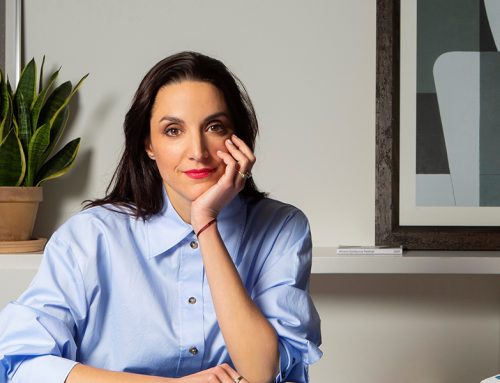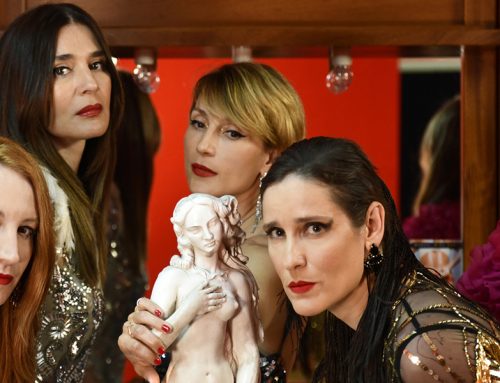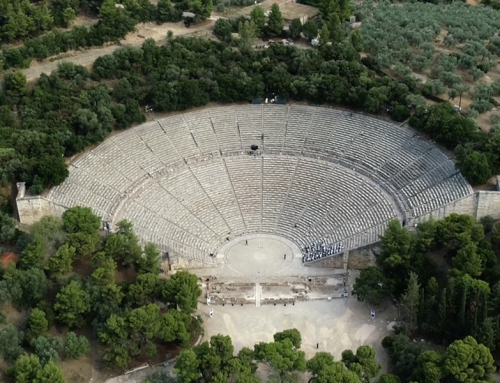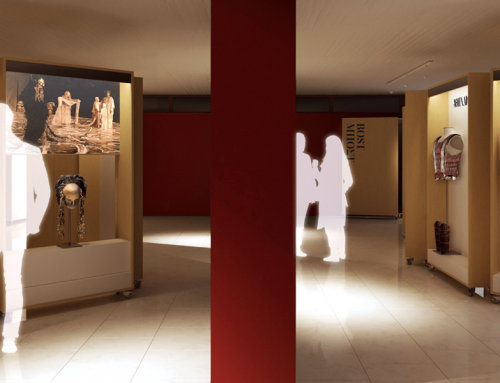Kamila Klamut, a prominent Polish stage and teacher, will teach at this year’s Epidaurus Lyceum. She shares her thoughts on her technique and its connection with music and singing, the Grotowski method, her relationship with Greece and her expectations from the Epidaurus Lyceum.
- Jerzy Grotowski’s Laboratory Theatre ended in 1984. A moment later, the Second Wrocław Studio was founded in the place of the theater’s activity. It was founded by one of the actors of the -Laboratory Theatre, Zbigniew Cynkutis. After completing the activities of the Second Wrocław Studio,The Centre for Study of Jerzy Grotowski’s Work and for Cultural and Theatrical Research was established in 1990, and was renamed in 2007 as the Grotowski Institute. On the one hand, the place nurtured documents and archives left over from the Laboratory Theatre, and at the same time it was a venue for the presentation of performances, organized workshops, conferences and discussions that somehow referred to the thought of Jerzy Grotowski. The Grotowski Center / Grotowski Institute was also the organizer of all presentation of „Action” by Workcenter of Jerzy Grotowski and Thomas Richards in Poland. So it was in the nineties, and it still is, a place of remembrance of the now-defunct Laboratory Theatre and its people. The Grotowski Institute is also a place where you can still meet former actors of the Laboratory Theatre, Rena Mirecka, Mieczysław Janowski, Maja Komorowska or co-founder of the theater Ludwik Flaszen. Personally, I had the pleasure to work practically with two actors from the Laboratory Theater – with Rena Mirecka and Zygmunt Molik. I have never been able to see performances of the Laboratory Theatre live. I’m just too young for it. I was a witness of “Action” in 1997 for the first time. Meanwhile, the Grotowski Institute is full of meetings with people who in the past created the phenomenon of the Laboratory Theatre, both on the part of the creators and viewers.
- Grotowski in the 1960s at the time when he created the Laboratory Theatre of 13 Rows – Institute for the Studies of the Method of Acting he said: “The basis of our method is the assumption that no one can be taught how to create, and that there are no perfect models that, imitating, we could create” And further:” We postulate a negative technique, that is – we suggest that the actor first of all determines what bothers him, resists, and to find an individual training that eliminates these obstacles at a given stage of his development”. In fact, Grotowski’s work consisted of constantly asking questions to one another and for the common cause of creating a theater. He was a great opponent of all orthodoxy. In his work he used various source techniques, but he was far from creating ready-made recipes for creating theater. His collaborators worked out their own training paths, like Zygmunt Molik, who developed the method of working with voice training or Rena Mirecka who engaged in art exercises and Ryszard Cieślak who created his way of working with the body but it is difficult to talk about a team of techniques that would be about the “Grotowski method”. Something like that simply does not exist. However, I think that Grotowski’s questions, which he posed when it comes to the presence of an actor on stage, his training, ethos of work etc. and the radicalism with which he approached his questions can be very inspiring for a contemporary performer.
- Both Jarek and I believe in a theater created from the spirit of music. Of course, there are different forms of manifestation of human expression, but this is what is closest to us. Although not the only one. In the performances of the ZAR Theater, we complete the musical score with an intense movement by the actors. The music that appears in our performances (sung live, sometimes accompanied by instruments) is based on songs most often from the liturgical tradition. (But not always. Song Zar, from which the group took its name, is the name of the funeral songs performed by Swans, living in high regions of the Caucasus in northwestern Georgia). We often learn at their source, by going to Georgia, Armenia, Greece (Athos), Bulgaria, Corsica or Sardinia. Expeditions, which are an integral part of our work philosophy, make the work on the performance not just a mere theater production but a larger cultural project. In addition, we believe that songs of tradition are a form of recording human experience related to work, life, spirituality and carry a huge load of memory of past generations. We want to share such energies in the theater.
- There was no ancient theater without music! The choir in ancient drama usually sang its songs. You could hear the instruments and see the music of the body which was dance. So it was a completely musical event. Rather, it is a great lesson of theater for us. I am reminded of the words of Ludwik Flaszen, who spoke about the Laboratory Theatre: “Our activity can be understood as an attempt to restitution of the archaic values of the theater. We are not modern, but on the contrary – quite traditional. Speaking jokingly, we are not an avant garde, but an arriergard”. I can to subscribe to these words referring to our work at the ZAR Theater.
- As a ZAR Theater, we have traveled to Greece several times. In the early 2000s, the male part of our group went to Athos. Personally, I came to Athens for the first time in 2006 when together with ZAR Theater we presented the performance “Gospels of Childhood” in the framework of the 4th edition of “Alternative Stage Festival”. For the second time in July 2017, ZAR Theater presented two performances “Armine, Sister” and “Medeas. On Getting Across” and led Witness/Action conference and workshops for acting students in Greece at the Forest Festival 2017 in Thessaloniki.
In Poland, we have a large diaspora of the Greek community. It comes mainly from the wave of emigration, which forced to leave Greece after the civil war. When my Greek friends talk about their journey to Epidaurus, their eyes are foggy and they talk about Epidaurus as a magical place. So this trip to Epidaurus is for me a journey to a magical place, to the place where theater begins and the birth of its power.
A few words about Kamila Klamut
Since the mid-1990s Kamila Klamut has been closely associated with the Grotowski Institute in Wrocław, Poland. In 1996, at the invitation of Grzegorz Bral and Anna Zubrzycki, she took part in forming Song of the Goat Theatre and performed in its first piece, Song of the Goat: Dithyramb. Since 1999 she has collaborated with Jarosław Fret, with whom she has been on several expeditions searching for the oldest extant forms of music.
She co-founded Teatr ZAR and appears in all three parts of Teatr ZAR’s triptych Gospels of Childhood, which has been performed in numerous cities around the world. Klamut co-created, with Mariana Sadovska, Camille, a piece inspired by the life and work of French sculptress Camille Claudel, which premiered in the Grotowski Institute in February 2014. In September 2014 she began collaborating with Studio Matejka, with which she performed in The Harmony of Contradictions: Poland, directed by Matej Matejka. Kamila Klamut closely collaborates on the Body Constitution programme that has been realised by the Grotowski Institute within the domain of research in practice. She is currently part of Teatr ZAR’s new project Armine, Sister.
For more information please visit www.kamilaklamut.pl and http://www.critical-stages.org/16/touchingcrossing-the-border-interview-with-kamila-klamut-and-ewa-pasikowska-teatr-zar/
Description of Klamut’s workshop at the Epidaurus Lyceum
Impossible Antigone / Insane Agave. What to do with them in the context of the theatre of physical expression.
Everything depends on the viewer’s point of view in the literal sense. How different are the optics of the spectator in the first row of the theatre and how different in the 35th? Jerzy Grotowski usually hosted 40 to 50 spectators at his performances, who could meet the actor almost at their fingertips, feel his scent, see every muscle twitch. From the perspective of the viewer in the 35th row the actor appears on the stage as a figure, a distant representation. And yet the common point of many of these ventures is the belief in the actor’s power of expression. In the case of an ancient theatre – amplified by a special acoustics of the theater or the use of cothurnus. So how did the same actor playing the role of Agave and Pentheus differentiate his roles? And how do we look at the power of expression of a physical actor today?
The workshop will serve to fine-tune the body’s attention, which on the one hand will pose a challenge to open and broaden the perception of the actor / human in his animal biological being, and on the other hand to develop the ability to observe what is internal, deeply connected with the presence. The workshop will be based on team exercises, elements of partner training and individual actions.
For information and applications (final deadline: 30 April 2019), please visit: https://aefestival.gr/epidaurus-lyceum/?lang=en









